Numerical Simulation and Experimental Research on Temperature Distribution of Fillet Welds
Abstract
1. Introduction
2. Welding Experiment
2.1. Materials and Welding Parameters
2.2. Experiment Method
3. Analytical Modeling
3.1. Assumptions and Descriptions of Heat Sources
3.2. Boundary Conditions
4. Results and Discussion
4.1. Determine the Heat Source Model Parameters
4.2. Model Validation
5. Conclusions
- Sensitivity analysis of double ellipsoid heat source model parameters indicated that the model parameters affect each other. When the heat flux increases in a certain direction, the heat flux will reduce in the other direction.
- Orthogonal experiments constructed with heat source model parameters, penetration depth, and width are calculated using regression analysis, and a matrix formula was obtained. A comparison of the measured and calculated temperature data suggests that consideration of ellipsoid heat source shape for predicting the transient temperature distribution on the welded plate is quite appropriate for the fillet welds process.
Author Contributions
Funding
Conflicts of Interest
References
- Zheng, M.; Ming, X. Construction of cyber-physical system–integrated smart manufacturing workshops: A case study in automobile industry. Adv. Mech. Eng. 2017, 9, 1–17. [Google Scholar] [CrossRef]
- Krahmer, D.M.; Polvorosa, R.; López de Lacalle, L.N.; Alonso-Pinillos, U.; Abate, G.; Riu, F. Alternatives for Specimen Manufacturing in Tensile Testing of Steel Plates. Exp. Tech. 2016, 40, 1555–1565. [Google Scholar] [CrossRef]
- López de Lacalle, L.N.; Lamikiz, A.; Muñoa, J.; Salgado, M.A.; Sánchez, J.A. Improving the high-speed finishing of forming tools for advanced high-strength steels (AHSS). Int J. Adv. Manuf. Technol. 2006, 29, 49–63. [Google Scholar] [CrossRef]
- Kim, Y.; Kim, J.; Kang, S. A Study on Welding Deformation Prediction for Ship Blocks Using the Equivalent Strain Method Based on Inherent Strain. Appl. Sci.-Basel 2019, 9, 4906. [Google Scholar] [CrossRef]
- Gu, X.; Liu, Y.; Li, W.; Han, Y.; Zheng, K. Physical Characteristics of Coupled Plasma and Its Influence on Weld Formation in Hybrid Laser-Double-Arc Welding. Materials 2019, 12, 4207. [Google Scholar] [CrossRef]
- Mishra, S.; DebRoy, T. A heat-transfer and fluid-flow-based model to obtain a specific weld geometry using various combinations of welding variables. J. Appl. Phys. 2005, 98. [Google Scholar] [CrossRef]
- Heinze, C.; Pittner, A.; Rethmeier, M.; Babu, S.S. Dependency of martensite start temperature on prior austenite grain size and its influence on welding-induced residual stresses. Comput. Mater. Sci. 2013, 69, 251–260. [Google Scholar] [CrossRef]
- Lu, Y.; Lu, C.; Zhang, D.; Chen, T.; Zeng, J.; Wu, P. Numerical computation methods of welding deformation and their application in bogie frame for high-speed trains. J. Manuf. Process. 2019, 38, 204–213. [Google Scholar] [CrossRef]
- Deng, D.; Kiyoshima, S. Numerical simulation of welding temperature field, residual stress and deformation induced by electro slag welding. Comput. Mater. Sci. 2012, 62, 23–34. [Google Scholar] [CrossRef]
- Lu, Y.; Zhu, S.; Zhao, Z.; Chen, T.; Zeng, J. Numerical simulation of residual stresses in aluminum alloy welded joints. J. Manuf. Process. 2020, 50, 380–393. [Google Scholar] [CrossRef]
- Miao, Y.; Han, D.; Yao, J.; Li, F. Effect of laser offsets on joint performance of laser penetration brazing for magnesium alloy and steel. Mater. Des. 2010, 31, 3121–3126. [Google Scholar] [CrossRef]
- Cheon, J.; Na, S.-J. Influence of simulation methods of temperature distribution on thermal and metallurgical characteristics in GMA welding. Mater. Des. 2016, 108, 183–194. [Google Scholar] [CrossRef]
- Yue, J.; Dong, X.; Guo, R.; Liu, W.; Li, L. Numerical simulation of equivalent heat source temperature field of asymmetrical fillet root welds. Int. J. Heat Mass Transf. 2019, 130, 42–49. [Google Scholar] [CrossRef]
- Rodgers, T.M.; Mitchell, J.A.; Tikare, V. A Monte Carlo model for 3D grain evolution during welding. Model. Simul. Mater. Sci. Eng. 2017, 25. [Google Scholar] [CrossRef]
- Yu, F.; Wei, Y.; Liu, X. The evolution of polycrystalline solidification in the entire weld: A phase-field investigation. Int. J. Heat Mass Transf. 2019, 142. [Google Scholar] [CrossRef]
- Zhao, M.S.; Lee, C.K.; Fung, T.C.; Chiew, S.P. Impact of welding on the strength of high performance steel T-stub joints. J. Constr. Steel. Res. 2017, 131, 110–121. [Google Scholar] [CrossRef]
- Sajek, A.; Nowacki, J. Comparative evaluation of various experimental and numerical simulation methods for determination of t 8/5 cooling times in HPAW process weldments. Arch. Civ. Mech. Eng. 2018, 18, 583–591. [Google Scholar] [CrossRef]
- Goldak, J.; Chakravarti, A.; Bibby, M. A New Finite Element Model for Welding Heat Sources. Metall. Mater. Trans. B 1984, 15, 299–305. [Google Scholar] [CrossRef]
- Kik, T. Computational Techniques in Numerical Simulations of Arc and Laser Welding Processes. Materials 2020, 13, 608. [Google Scholar] [CrossRef] [PubMed]
- Kim, C.H.; Zhang, W.; DebRoy, T. Modeling of temperature field and solidified surface profile during gas–metal arc fillet welding. J. Appl. Phys. 2003, 94, 2667–2679. [Google Scholar] [CrossRef]
- Fachinotti, V.D.; Anca, A.A.; Cardona, A. Analytical solutions of the thermal field induced by moving double-ellipsoidal and double-elliptical heat sources in a semi-infinite body. Int. J. Numer. Meth. Biomed. 2011, 27, 595–607. [Google Scholar] [CrossRef]
- Winczek, J. Modeling of Temperature Field during Multi-Pass GMAW Surfacing or Rebuilding of Steel Elements Taking into Account the Heat of the Deposit Metal. Appl. Sci. Basel 2016, 7, 6. [Google Scholar] [CrossRef]
- Azar, A.S.; Ås, S.K.; Akselsen, O.M. Determination of welding heat source parameters from actual bead shape. Comput. Mater. Sci. 2012, 54, 176–182. [Google Scholar] [CrossRef]
- Ghosh, A.; Chattopadhyay, H. Mathematical modeling of moving heat source shape for submerged arc welding process. Int. J. Adv. Manuf. Technol. 2013, 69, 2691–2701. [Google Scholar] [CrossRef]
- Ghosh, A.; Yadav, A.; Kumar, A. Modelling and experimental validation of moving tilted volumetric heat source in gas metal arc welding process. J. Mater. Process. Technol. 2017, 239, 52–65. [Google Scholar] [CrossRef]
- Derakhshan, E.D.; Yazdian, N.; Craft, B.; Smith, S.; Kovacevic, R. Numerical simulation and experimental validation of residual stress and welding distortion induced by laser-based welding processes of thin structural steel plates in butt joint configuration. Opt. Laser Technol. 2018, 104, 170–182. [Google Scholar] [CrossRef]
- Muránsky, O.; Hosseinzadeh, F.; Hamelin, C.J.; Traore, Y.; Bendeich, P.J. Investigating optimal cutting configurations for the contour method of weld residual stress measurement. Int. J. Pressure Vessels Pip. 2018, 164, 55–67. [Google Scholar] [CrossRef]
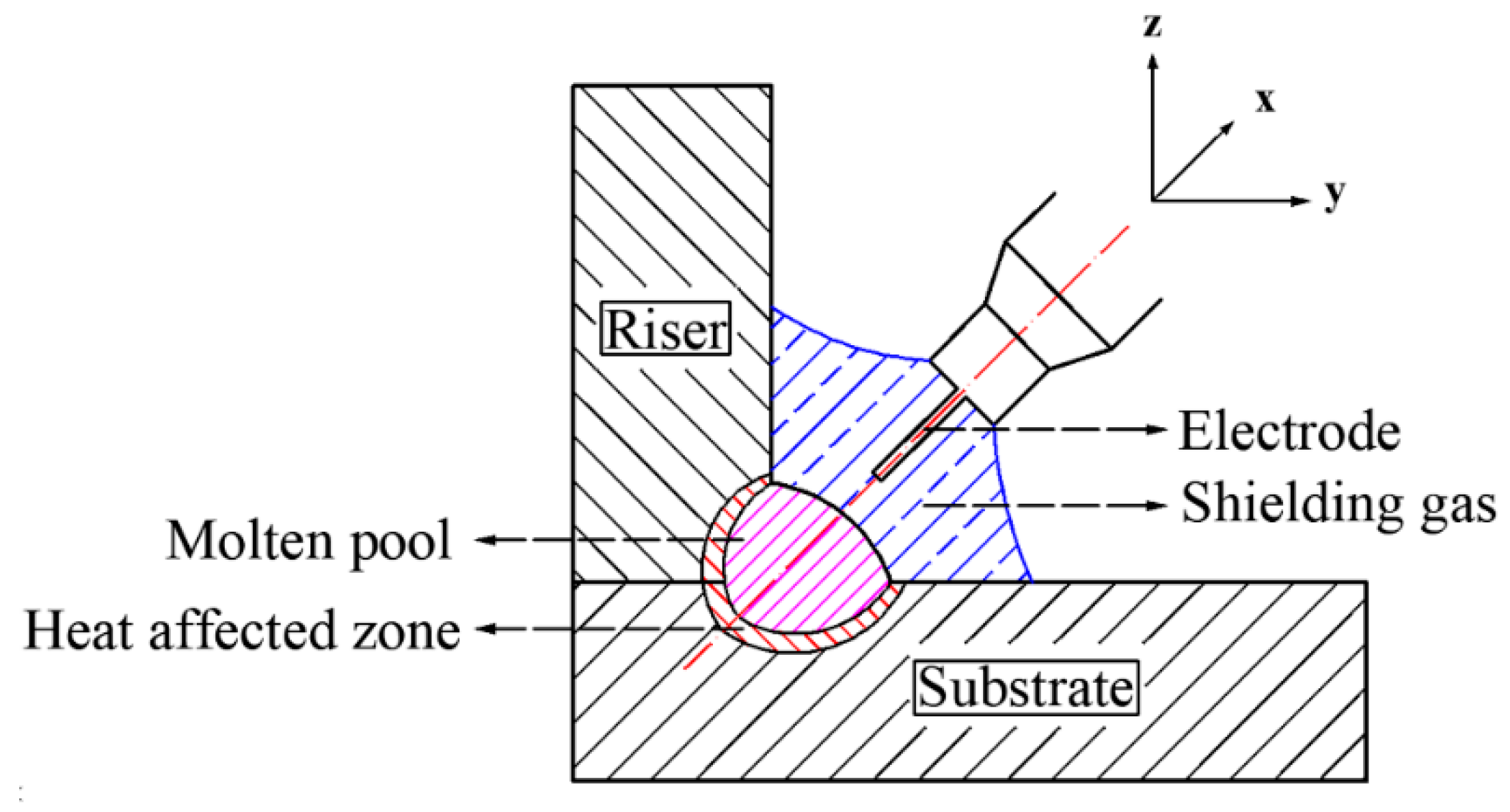
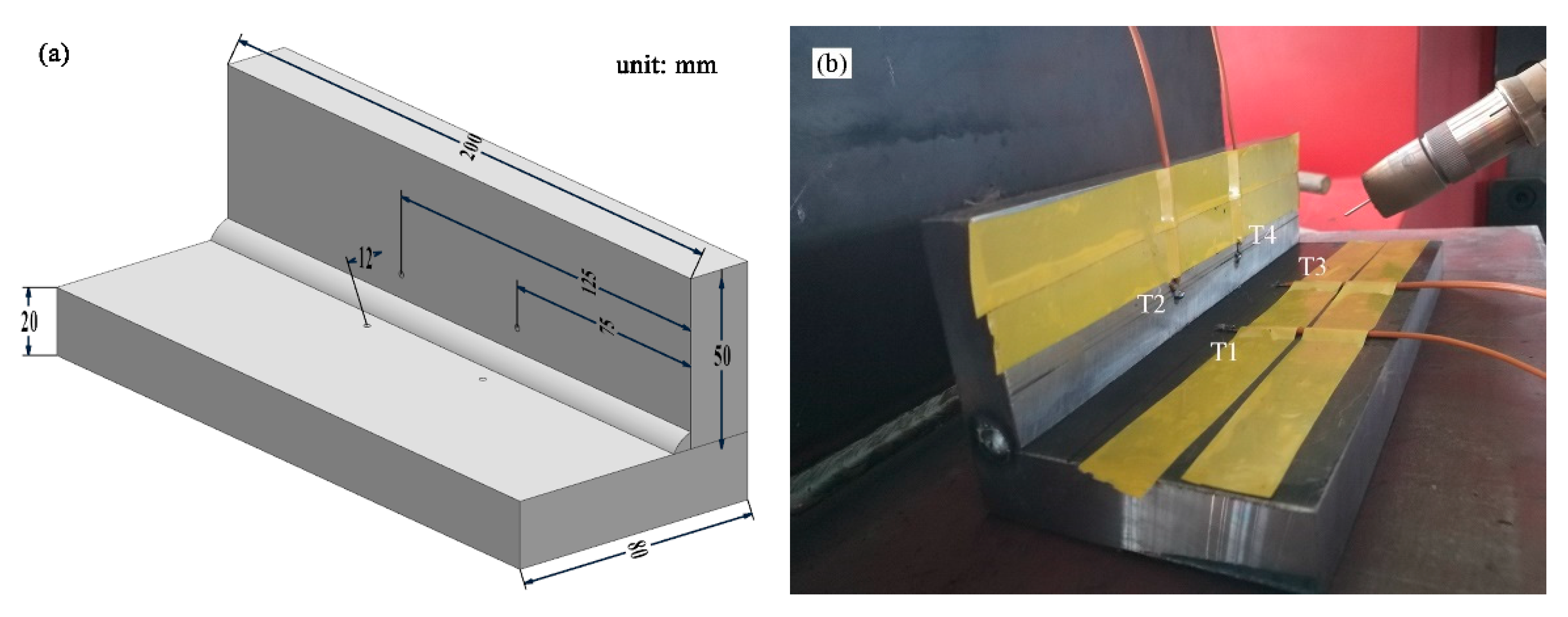
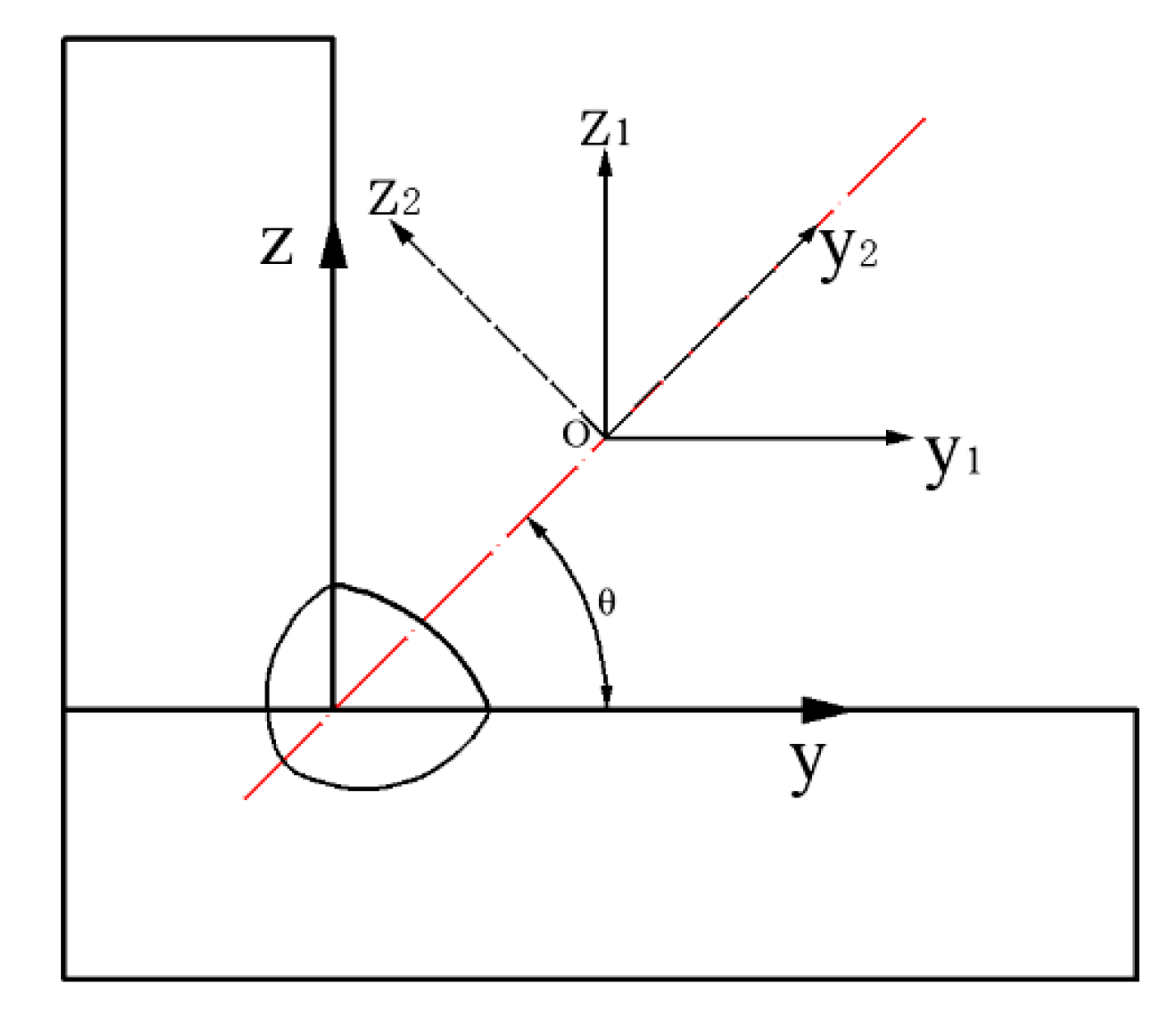
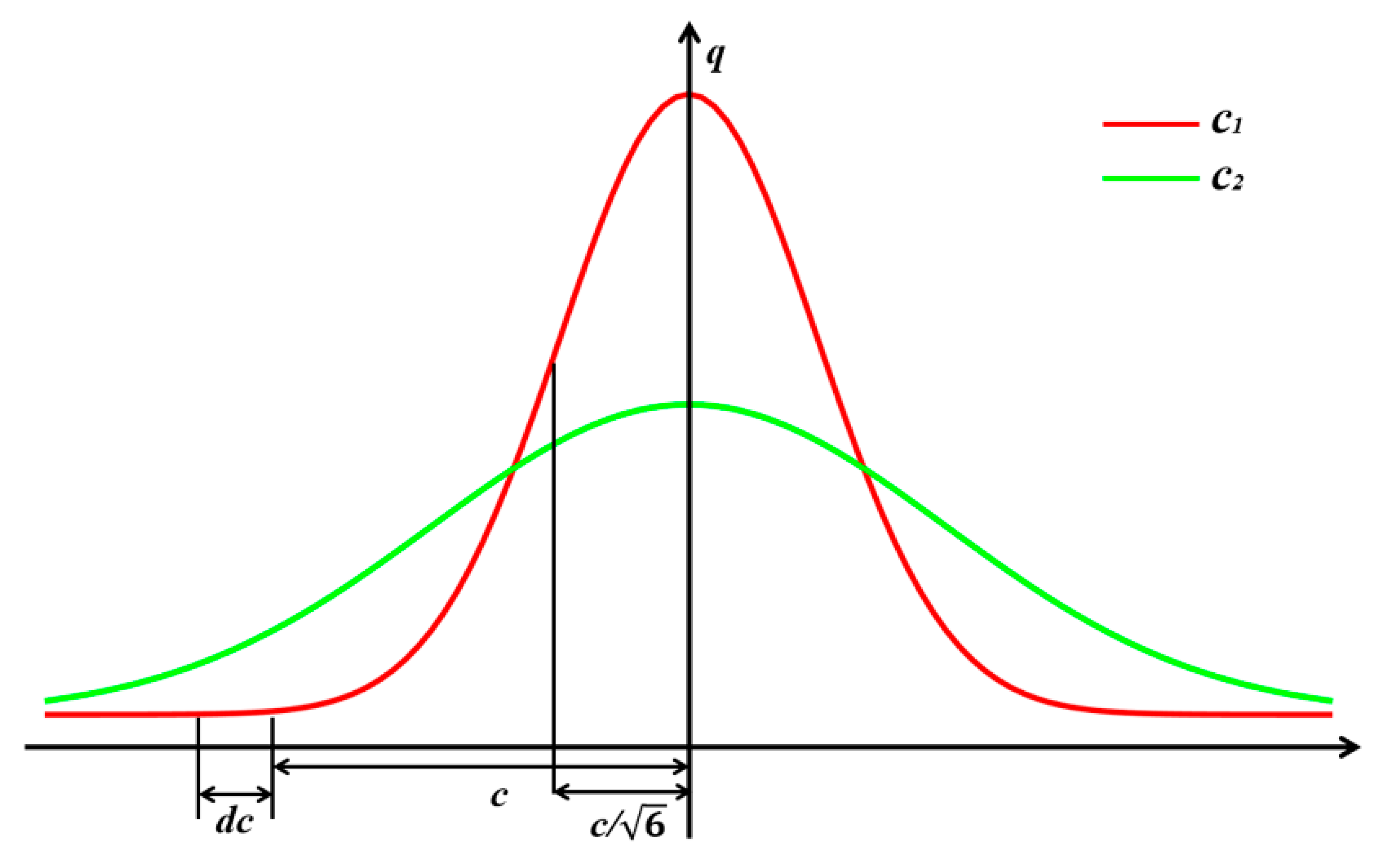
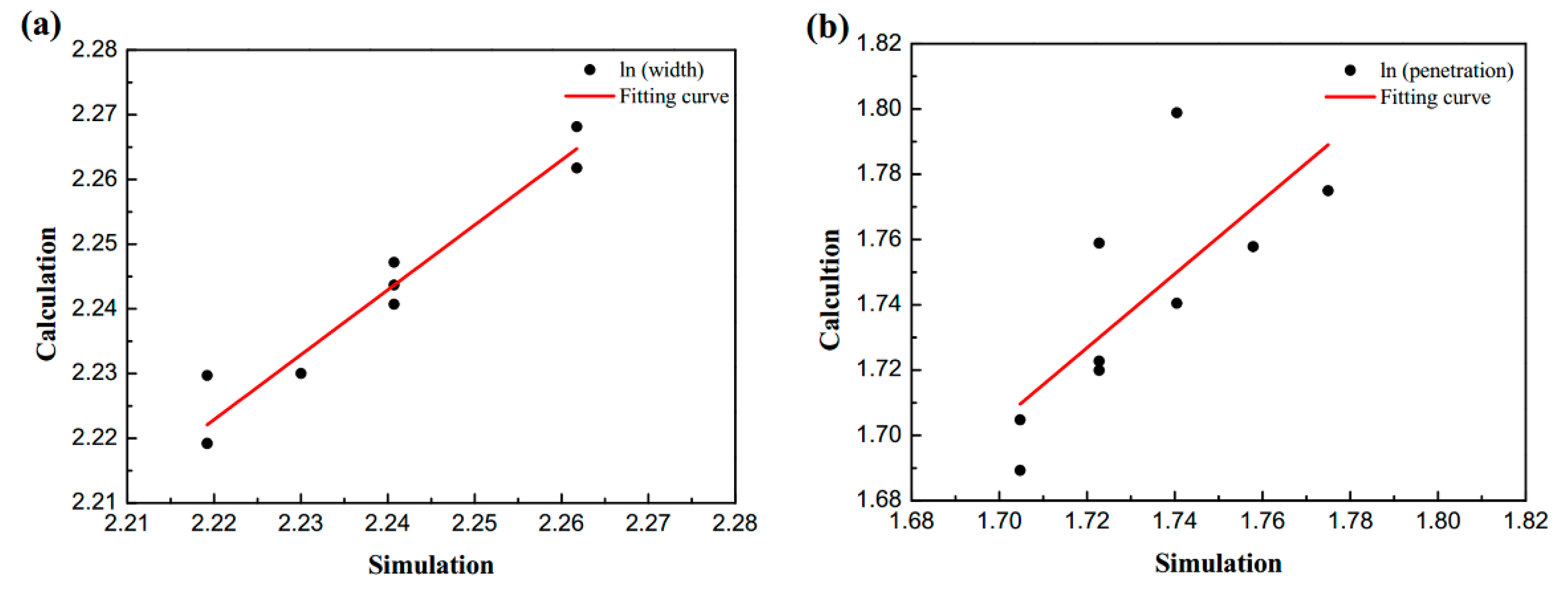
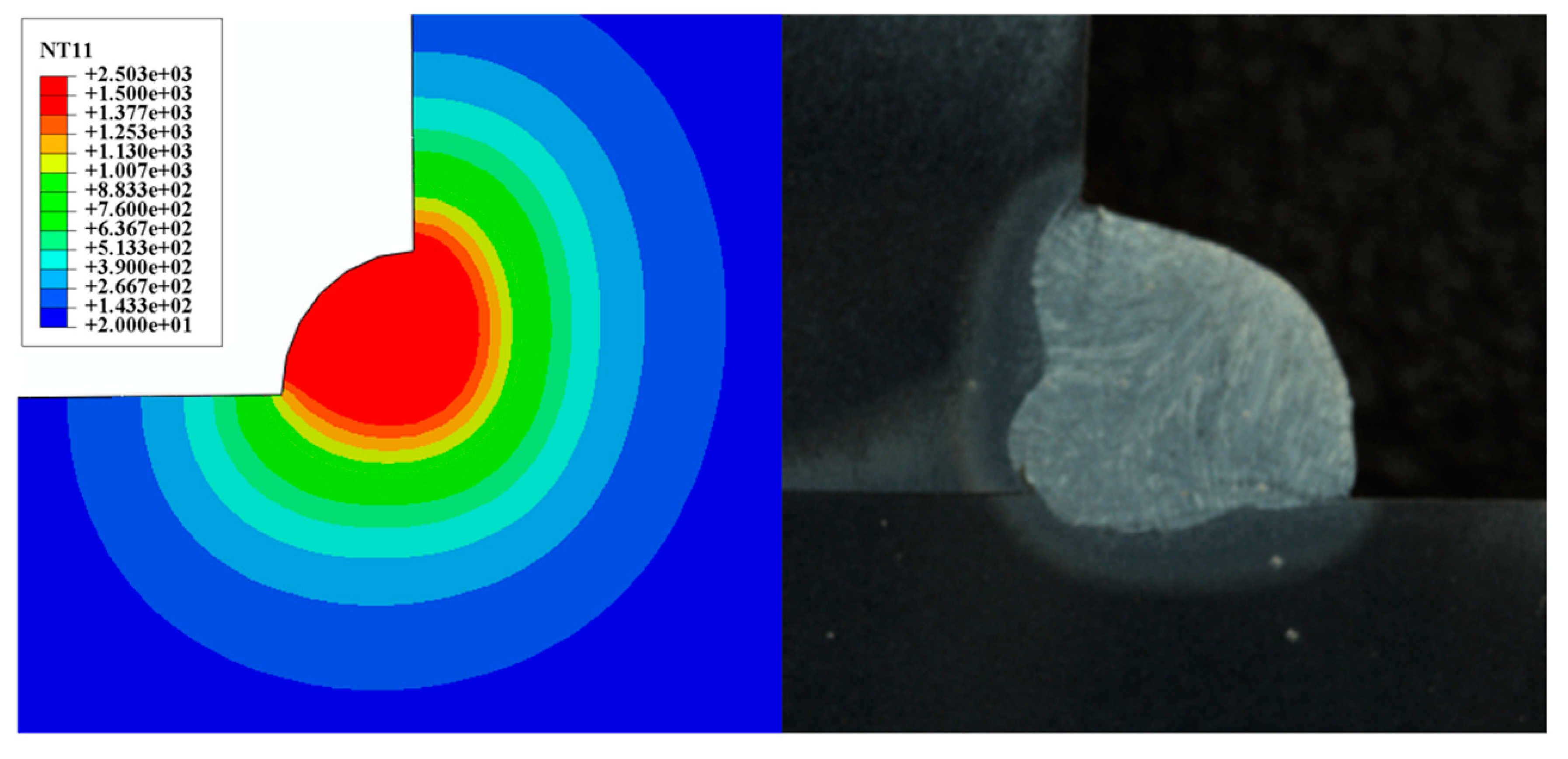


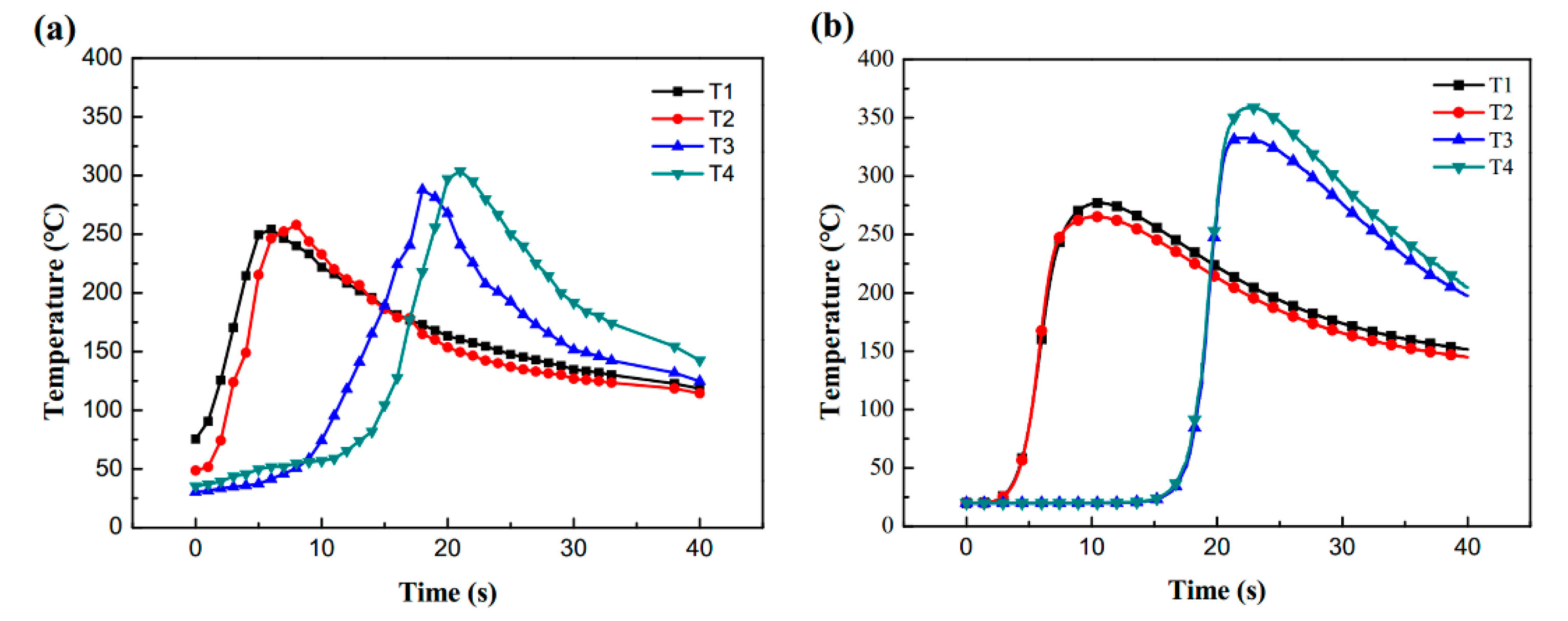
| Chemical Composition | C | Si | Mn | P | S | Cr | Fe |
|---|---|---|---|---|---|---|---|
| Workpiece (Q235) | 0.16 | 0.14 | 0.70 | 0.03 | 0.02 | 0.02 | Balance |
| Electrode (ER50-6) | 0.08 | 0.87 | 1.45 | 0.012 | 0.013 | 0.03 | Balance |
| MAG Setup | Fully Automatic |
|---|---|
| Shielding gas | 80% Ar + 20% CO2 |
| Power source | Constant current |
| Electrode | ER50-6(φ 1.2) |
| Polarity | DC+ |
| Welding current | 170 A |
| Arc voltage | 22 V |
| Flow rate of shielding gas | 15 L/min |
| Welding speed | 300 mm/min |
| Ambient temperature | 20 °C |
| CTWD | 12 mm |
| Torch angle | 45° |
| Sample | af (mm) | ar (mm) | b (mm) | c (mm) | w (mm) | p (mm) |
|---|---|---|---|---|---|---|
| 1# | 4 | 11 | 4.5 | 4 | 9.6 | 5.7 |
| 2# | 4 | 12 | 5 | 4.3 | 9.4 | 5.6 |
| 3# | 4 | 13 | 5.5 | 4.5 | 9.2 | 5.6 |
| 4# | 4.5 | 11 | 5 | 4.5 | 9.6 | 5.9 |
| 5# | 4.5 | 12 | 5.5 | 4 | 9.2 | 5.7 |
| 6# | 4.5 | 13 | 4.5 | 4.3 | 9.3 | 5.5 |
| 7# | 5 | 11 | 5.5 | 4.3 | 9.4 | 5.8 |
| 8# | 5 | 12 | 4.5 | 4.5 | 9.4 | 5.6 |
| 9# | 5 | 13 | 4 | 4 | 9.2 | 5.5 |
| - | Parameters (mm) | Penetrate (mm) | Width (mm) | |||||
|---|---|---|---|---|---|---|---|---|
| af | ar | b | c | Simulation | Experiment | Simulation | Experiment | |
| 1# | 4.38 | 13.14 | 4.12 | 4.38 | 5.3 | 5.5 | 9.6 | 9.4 |
| 2# | 4.65 | 13.95 | 3.07 | 4.65 | 5.1 | 5.3 | 9.7 | 9.6 |
© 2020 by the authors. Licensee MDPI, Basel, Switzerland. This article is an open access article distributed under the terms and conditions of the Creative Commons Attribution (CC BY) license (http://creativecommons.org/licenses/by/4.0/).
Share and Cite
Zuo, S.; Wang, Z.; Wang, D.; Du, B.; Cheng, P.; Yang, Y.; Zhang, P.; Lang, N. Numerical Simulation and Experimental Research on Temperature Distribution of Fillet Welds. Materials 2020, 13, 1222. https://doi.org/10.3390/ma13051222
Zuo S, Wang Z, Wang D, Du B, Cheng P, Yang Y, Zhang P, Lang N. Numerical Simulation and Experimental Research on Temperature Distribution of Fillet Welds. Materials. 2020; 13(5):1222. https://doi.org/10.3390/ma13051222
Chicago/Turabian StyleZuo, Shanchao, Ziran Wang, Decheng Wang, Bing Du, Peng Cheng, Yicheng Yang, Ping Zhang, and Ning Lang. 2020. "Numerical Simulation and Experimental Research on Temperature Distribution of Fillet Welds" Materials 13, no. 5: 1222. https://doi.org/10.3390/ma13051222
APA StyleZuo, S., Wang, Z., Wang, D., Du, B., Cheng, P., Yang, Y., Zhang, P., & Lang, N. (2020). Numerical Simulation and Experimental Research on Temperature Distribution of Fillet Welds. Materials, 13(5), 1222. https://doi.org/10.3390/ma13051222




